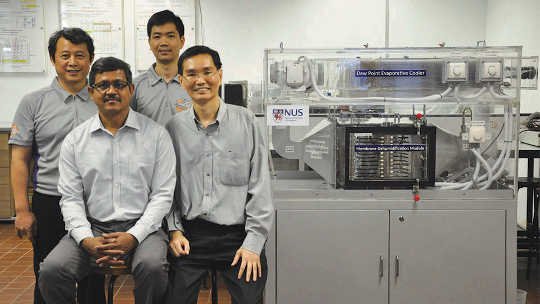
A new water-based air-conditioning system cools air to as low as 18 degrees Celsius (about 64 degrees Fahrenheit) without using energy-intensive compressors and environmentally harmful chemical refrigerants.
“…our technology has immense potential to disrupt how air-conditioning has traditionally been provided…”
This technology could potentially replace the century-old air-cooling principle that is still used in modern-day air-conditioners. Suitable for both indoor and outdoor use, the new system is portable and can be customized for all types of weather conditions.
The team’s novel air-conditioning system is cost-effective to produce, and it is also more eco-friendly and sustainable.
The system consumes about 40 percent less electricity than current compressor-based air-conditioners used in homes and commercial buildings. This translates into more than 40 percent reduction in carbon emissions. In addition, it adopts a water-based cooling technology instead of using chemical refrigerants such as chlorofluorocarbon and hydrochlorofluorocarbon for cooling, thus making it safer and more environmentally-friendly.
The system also generates potable drinking water while it cools ambient air.
“For buildings located in the tropics, more than 40 percent of the building’s energy consumption is attributed to air-conditioning. We expect this rate to increase dramatically, adding an extra punch to global warming,” says lead researcher Ernest Chua, associate professor in the mechanical engineering department in the National University of Singapore’s Faculty of Engineering.
“First invented by Willis Carrier in 1902, vapor compression air-conditioning is the most widely used air-conditioning technology today. This approach is very energy-intensive and environmentally harmful,” Chua explains. “In contrast, our novel membrane and water-based cooling technology is very eco-friendly—it can provide cool and dry air without using a compressor and chemical refrigerants.
“This is a new starting point for the next generation of air-conditioners, and our technology has immense potential to disrupt how air-conditioning has traditionally been provided,” he adds.
Current air-conditioning systems require a large amount of energy to remove moisture and to cool the dehumidified air. By developing two systems to perform these two processes separately, the researchers can better control each process and achieve greater energy efficiency.
To remove moisture from humid outdoor air, the air-conditioning system first uses an innovative membrane technology—a paper-like material. A dew-point cooling system that uses water as the cooling medium instead of harmful chemical refrigerants then cools the dehumidified air.
Unlike vapor compression air-conditioners, the novel system does not release hot air to the environment. Instead, a cool air stream that is comparatively less humid than environmental humidity is discharged—negating the effect of micro-climate. About 12 to 15 liters of potable drinking water can also be harvested after operating the air-conditioning system for a day.
“Our cooling technology can be easily tailored for all types of weather conditions, from humid climate in the tropics to arid climate in the deserts,” Chua says. “While it can be used for indoor living and commercial spaces, it can also be easily scaled up to provide air-conditioning for clusters of buildings in an energy-efficient manner.
“This novel technology is also highly suitable for confined spaces such as bomb shelters or bunkers, where removing moisture from the air is critical for human comfort, as well as for sustainable operation of delicate equipment in areas such as field hospitals, armored personnel carriers, and operation decks of navy ships as well as aircrafts,” adds Chua.
The research team is currently refining the design of the air-conditioning system to further improve its user-friendliness. The researchers are also working to incorporate smart features such as pre-programmed thermal settings based on human occupancy and real-time tracking of its energy efficiency. The team hopes to work with industry partners to commercialize the technology.
The Building and Construction Authority and National Research Foundation Singapore supported the research.
{youtube}kdutQc9Om1Y{/youtube}
Source: National University of Singapore
Related Books
at InnerSelf Market and Amazon





























